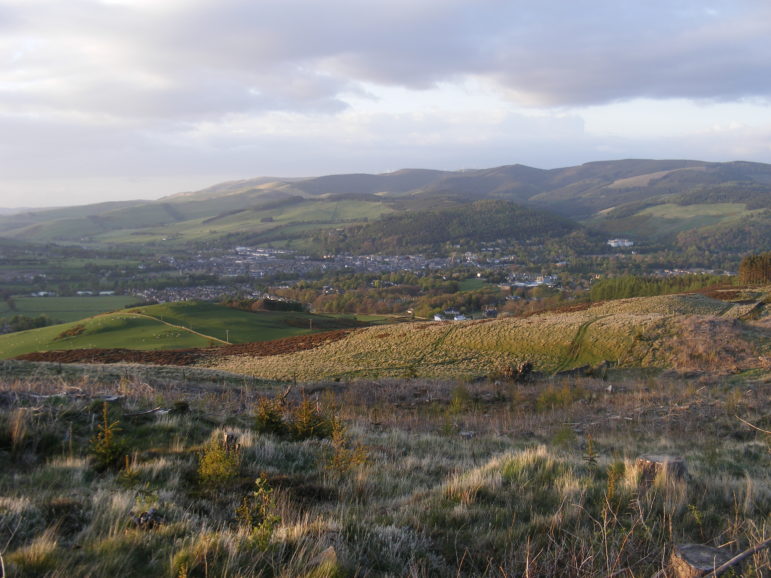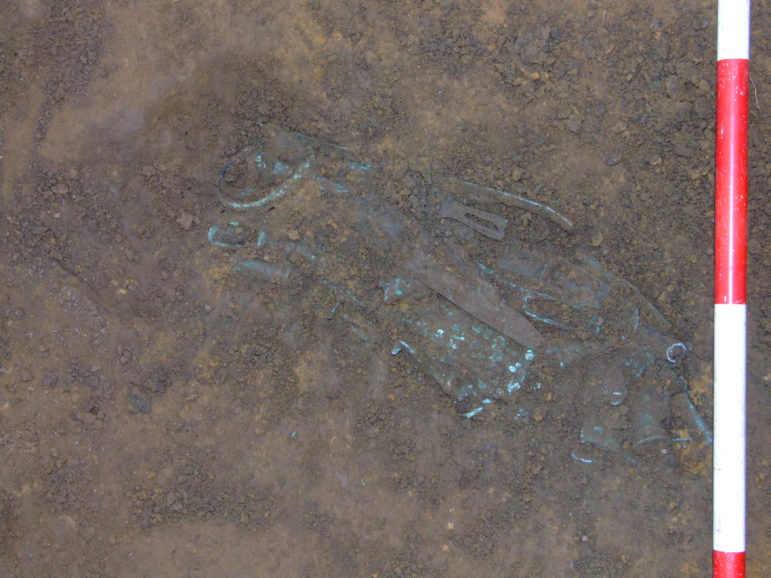PEEBLES, Scotland – In June 2020, a group of metal detectorists, including Mariusz Stepien, decided to investigate a field near Peebles in Scotland. Stepien, believing that he had made a discovery, immediately contacted Scotland’s Treasure Trove Unit (TTU) who brought in the archaeologists and conducted a dig over the next month.

A view over Peebles, Borders, Scotland, from one of several access routes to nearby Cademuir Hill – Image credit: Viewfinder – Public Domain
Stepien had indeed made a significant find: a 3000 year old Bronze Age treasure trove, including a bronze sword and scabbard, an unusual horse’s harness, and wheel caps.
TTU head Emily Freeman told the BBC that, “This is a nationally significant find—so few Bronze Age hoards have been excavated in Scotland, it was an amazing opportunity for us to not only recover bronze artifacts, but organic material as well.”
The hoard was so well preserved that it allowed archaeologists to link items together and get a better picture of how they had been constructed.
The metal detectorists behaved responsibly, camping nearby to protect the hoard from treasure seekers: archaeological sites in the U.K. have been damaged in the past by over-zealous or simply unscrupulous visitors. Their reward was to see the progress of the archaeological dig.
Stepien himself is quoted as saying, “Every day there were new objects coming out which changed the context of the find, every day we learned something new. I’m so pleased that the earth revealed to me something that was hidden for more than 3,000 years. I still can’t believe it happened.”
He is right to have ‘shaken with happiness’ when he realised that the find was significant: only one other similar Bronze Age hoard, the Horsehope Craig Hoard, has been discovered in Scotland, and that in the late 1800s, which also contained horse harnesses. The sword itself is one of only three such artifacts to have been discovered in the whole of the U.K.
However, although many amateur archaeologists get excited about weapons, it is the rare type of harness bell that is attracting particular attention with regard to the Peebles hoard.
This rattle pendant, which would sound whenever the horse moved, is the first to be found in Scotland and it is hoped that this find and the accompanying harness will shed more light on the history of the domestication of the horse in early Scotland.
Curator of Prehistory at the National Museum of Scotland, Dr Matthew Knight explained, “Having a horse would have been a symbol of power and the sword speaks to that as well. To deck out a horse in this harness is part of this expression of power. When you think about the rattle pendant, you can imagine the horse jangling as it moves. This wasn’t just about harnessing your horse, this was about making sure that it was decked out. This was about showing off your horse.”
Moreover the harness, including the bell, was found buried in part of a wall, suggesting that it had been placed there deliberately, perhaps as part of an offering.
Dr Knight said, “If you have a complete horse harness and sword, then you are also making a powerful gesture by giving them up. These items hold a lot of bronze, a lot of organics, such as leather, and it takes time and effort to make them. To offer them up is a significant action… We are still working of the interpretation of these items but it is entirely possible that the person who owned these items died and then it was seen as necessary to bury these things. Similarly, it could also be about moving on with the feeling that ‘this settlement has provided well for us, and here is an offering…
“These harnesses are extremely rare, there is very little like it in Scotland and some of the items found are better compared to northern England. We are looking at a well-connected community, with the design of the items suggesting links to Ireland and Continental Europe. It is likely that these people had never seen objects like this before.”
The archaeological team extracted the entire trove in a large block of soil in order to protect it. This block was covered in a fine mesh and sent to the laboratory.

A late Bronze Age hoard found in Wiltshire 2012 – Image credit: The Portable Antiquities Scheme/ The Trustees of the British Museum, CC BY-SA 2.0
Freeman explained the process, “Because of the complexity of the hoard, we had to lift it as a block … At the moment, a lot of the objects are still in soil. So the immediate next steps will be excavating those objects. And then it will go through the treasure trove process and it will be allocated to a Scottish museum.”
The Queen’s and Lord Treasurer’s remembrancer David Harvie says the Bronze Age treasure hoard is “highly significant and promises to give us a new insight into Scotland’s history.”
Meanwhile the Carnoustie collection, a hoard dating from around 2000 years ago and discovered in 2016, is still waiting to be allocated to a museum and this probably won’t happen until 2021. This collection, too, contains a number of swords.
Dr Chris Brewer said, “Post-excavation work on the Carnoustie hoard has not yet reached the stage to allow formal reporting to begin the process of allocation through the Treasure Trove Scheme.
“As I understand it, the hoard is likely to come before the Scottish Archaeological Finds Allocation (SAFAP) at some point next year, at the earliest. National Museums Scotland is interested in acquiring the hoard and as a result has discussed this interest informally with colleagues at Angus Alive museum service, in advance of any formal process.
“Colleagues at Angus have communicated their interest to National Museums Scotland in applying for some of the hoard on loan should it be allocated to NMS and this has been discussed by our collections committee.”
Carnoustie Library, meanwhile, has a replica display of some of the items found. Angus Alive museums exhibitions lead Rachel Jackson, said, “[This] display will provide the opportunity for visitors to Carnoustie Library to find out more about the remarkable assemblage through detailed models of the excavation site and view replicas of the objects which were discovered, explaining the process the actual finds have to go through to ensure their conservation for future generations.”
Needless to say, efforts to contain and control the spread of COVID-19 has held up a number of these processes, which can be lengthy and complex, but the recent Peebles find at least suggests that some progress is being made when it comes to finding out more about Scotland’s ancient past.
The Wild Hunt is not responsible for links to external content.
To join a conversation on this post:
Visit our The Wild Hunt subreddit! Point your favorite browser to https://www.reddit.com/r/The_Wild_Hunt_News/, then click “JOIN”. Make sure to click the bell, too, to be notified of new articles posted to our subreddit.